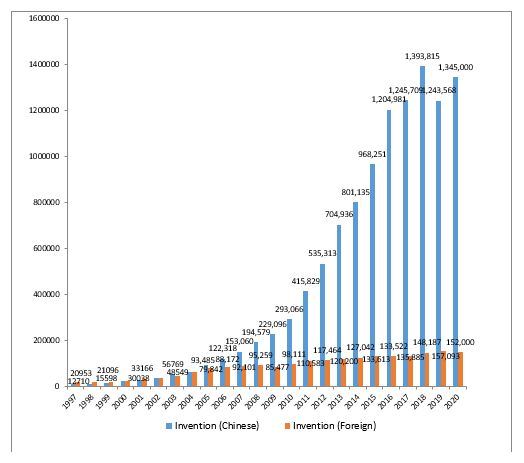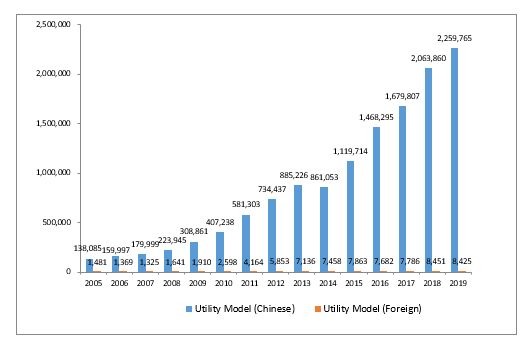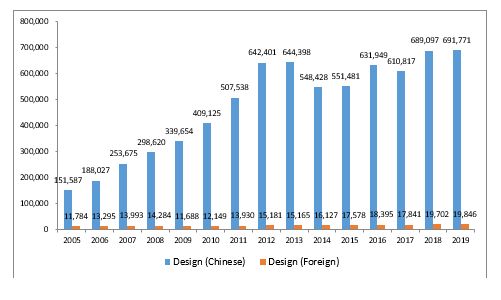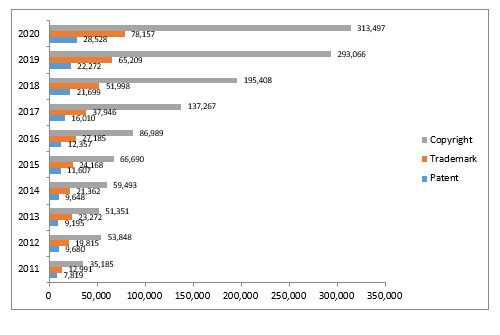Published in Landslide, Vol. 14, No. 2, December/January 2022, by the American Bar Association
Since China's patent law came into effect on April 1, 1985, the number of patent applications filed each year with China's patent authority, the China National Intellectual Property Administration (CNIPA), has increased dramatically. Over the years, the Chinese government has implemented various legislative changes, policies, and directives to improve and direct China's patent system toward the government's goals at any given time. Such changes, policies, and directives have significantly impacted how the perception of patents and intellectual property (IP) generally has evolved within China.
One of the most significant policies has been the provision of direct financial subsidies to patent filers, in addition to tax breaks and other social benefits that stem directly from being a patent owner or filer. These subsidies have been an important driver in jump-starting the Chinese patent system, including driving an enthusiasm and interest in patents that did not exist before. A negative consequence of China's patent subsidies has been the proliferation of junk patents and abnormal patent application behavior, with applicants filing patents-with the help of a cottage industry of patent agencies-not to protect valuable innovation, but to profit from subsidies that can exceed patent filing fees.
The Chinese government has long been aware of the unintended incentive system created by its patent subsidies, and has for years attempted steps at remedying it. Finally, the Chinese government has announced the complete phasing-out of all existing patent subsidies. This change comes within what appears to be a larger shift in China's IP policy. For over a decade, China's stated policy goal has been to improve both the quantity and quality of its domestic patent holdings and commercialization. The government's subsidy incentive structure favored quantity, perhaps at the expense of quality. Now, policy changes around China's incentive structures signal a concerted effort to refocus on quality rather than quantity, where the central and local governments may use incentives to drive the direction of IP development rather than the speed of its growth.
Chinese Patent Rights
China provides three types of patent rights: invention patents (equivalent to utility patents in the U.S.), utility model patents (called "petty patents" in some countries), and design patents (similar to U.S. design patents). Figure 1 shows that beginning in 2003, invention patent filings with the CNIPA from Chinese applicants overtook those from foreign applicants. The gap between domestic and foreign filers continued to grow steadily through the late 2000s, until beginning to grow exponentially after 2009 or 2010. Figures 2 and 3 show a similar growth in utility model and design patent filings, although unlike invention patents, domestic filers of utility model and design patents always outnumbered foreign filers. Figures 1, 2, and 3 show that the growth rates for domestic filings of all three types of patents appear to speed up around 2009 (although design patent filings begin to plateau). The Chinese government's policy plays a key role in the amazing increase of filings.

Figure 1. Invention patent filing statistics, 1997-2020. (Data from CNIPA Annual Statistics, available at https://www.cnipa.gov.cn/col/col61/index.html )

Figure 2. Utility model patent filing statistics, 2005-2019. (Data from CNIPA Annual Statistics, available at https://www.cnipa.gov.cn/col/col61/index.html.)

Figure 3. Design patent filing statistics, 2005-2019. (Data from CNIPA Annual Statistics, available at https://www.cnipa.gov.cn/col/col61/index.html)
Origin of Patent Subsidiesg
On June 5, 2008, China's State Council issued the Outline of the National Intellectual Property Strategy,1 the first time that IP was regarded strategically on a national level in China. The long-term strategic goal in the outline was that by 2020, China would "become a country with a comparatively high level in terms of the creation, utilization, protection and administration of [IP rights]."2 The outline set a national policy objective to get the annual number of Chinese invention patents granted to domestic applicants to rank among "the advanced countries of the world" within the next five years.3 The 12th Five-Year Plan (2011-2015) for National Economic and Social Development4 included patent-related objectives for the first time, targeting 3.3 invention patents per 10,000 people.5 The 13th Five-Year Plan (2016-2020) aimed for 12 invention patents per 10,000 people by 2020.6
To execute the National Intellectual Property Strategy and achieve the specific quantitative goals of the five-year plans, China's central and local governments, and even high-tech parks, deployed patent-filing incentive programs.
IP Industry Changed by Financial and Other Benefits
The January 11, 2007, Interim Administrative Measures for Beijing Patent Application Supporting Fund is an example of the types of incentive programs established across China around the time of the Outline of the National Intellectual Property Strategy. According to the measures, a Beijing entity could receive up to ¥5,000 (about $770) for each invention patent application and ¥500 (about $77) for each utility model or design patent application.7 The incentives increase as more patents are filed and granted. For each entity, starting with the 101st invention application filed in a year, an additional ¥1,000 (about $154) is available per application filed, and an additional ¥1,500 (about $231) per patent granted. A Beijing entity may also receive up to ¥500,000 (about $77,000) each year for filing foreign patent applications, including Patent Cooperation Treaty (PCT) applications. Most of the financial support is not conditioned on the patent being granted.8 Lesser subsidies are available for utility model and design patent applications, but these applications are not substantively examined. Similar financial incentives exist in provinces and cities across China, inevitably enticing domestic applicants to file patent applications, not to protect any inventive discovery, and even for obviously ineligible subject matter, just to collect government subsidies.
In addition to direct subsidies, patent filings help businesses across China enjoy the reduced tax rate for "high-tech companies." According to China's Corporate Income Tax Law (effective January 1, 2008, shortly before the Outline of the National Intellectual Property Strategy), a high-tech company enjoys a reduced corporate income tax rate of 15%, down from the normal corporate tax rate of 25%.9 Patent filings are an important factor in the weighted scoring system used to determine whether a company qualifies as a high-tech company.10 Companies must recertify as high-tech every three years, incentivizing even more patent filings.
Patent applications and grants have other business, social, and legal benefits in China. Businesses use patent certificates to promote their products as patented. Technical persons and academics can use patent certificates to help them apply for academic titles. Patents are even valuable in grade school. Patent filings and grants can help elementary and junior high school students when applying to higher levels of school, and having a patent grant enables Chinese high school graduates to apply to university through independent enrollment programs,11 bypassing extremely competitive entrance exams. Patents can also benefit criminals. The Provisions of the Supreme People's Court on the Specific Application of Law in Handling Commutation and Parole Cases,12 issued by the Supreme People's Court on November 14, 2016, prescribe that a criminal being granted an invention patent during their sentence counts as a "major meritorious service," for which a commutation not exceeding a fixed-term imprisonment of 18 months can be granted.
The multiple benefits and advantages patents bring to applicants, and the corresponding enthusiasm around patent filings, stimulated growth in the IP service industry. In 2010, there were 796 patent agencies legally established.13 This number became 2,691 by 2019, among which 45.2% of the agencies were established between 2017 and 2019.14 It is an open secret that the subsidies for patent applications and grants can be greater than applicants' filing expenses. This calculus factors into the business of the IP service industry, driving the increasing number of filings, and helping the Chinese government meet the quantitative objectives set in 2008.
By the end of 2020, there were: (1) 3,057,844 maintained and valid invention patents in China, of which 74.5% (or 2,279,123) were owned by domestic applicants and 25.5% (or 778,721) were owned by foreign applicants; (2) 6,947,697 maintained and valid utility model patents, of which 99.3% (or 6,895,886) were owned by domestic applicants and 0.7% (or 51,811) were owned by foreign applicants; and (3) 2,187,356 maintained and valid design patents in China, of which 94.3% (or 2,061,859) were owned by domestic applicants and 5.7% (or 125,497) were owned by foreign applicants.15 At the end of 2020, there were 15.8 patents per 10,000 people in mainland China, exceeding the goal of 12 patents per 10,000 set in the 13th Five-Year Plan.16
Crackdown on Junk Patents
The open secret of applicants and agents filing patents solely to obtain government subsidies has garnered criticism from China's IP practitioners, academic community, and media. The criticism focuses on the large number of junk patents as a result of the increased filings.
As early as 2007, the CNIPA (known at the time as the State Intellectual Property Office (SIPO)) issued Several Provisions Regarding the Regulation of Patent Application Behavior to prevent the filing of abnormal or irregular patent applications.17 The provisions defined "abnormal patent application behavior" as: (1) the same entity or individual filing or directing others to file multiple patent applications with obviously the same content; (2) the same entity or individual filing or directing others to file multiple patent applications that clearly plagiarize existing technology or existing designs; and (3) patent agencies filing patent applications described in item (1) or (2).
In 2017, in response to specific problems identified during patent examination, the SIPO added four items to the definition of abnormal patent application behavior: (1) the same entity or individual filing multiple patent applications for simple replacement or patchwork of different materials, components, ratios, parts, etc.; (2) the same entity or individual filing multiple patent applications with obviously fabricated experimental data or technical effects; (3) the same entity or individual filing multiple patent applications that use computer technology to randomly generate product shapes, patterns, or colors; and (4) helping others to do anything defined as abnormal patent application behavior.18
After the 2017 revisions failed to stop abnormal patent application behavior, the CNIPA began taking relatively serious disciplinary measures. The CNIPA issued a total of 18 sanctions on March 26, 2019, against 12 individuals and six patent agencies.19 The sanctioned behavior included a patent agency filing 75 patent applications with the same content on behalf of multiple applicants, a patent agency disclosing one client's undisclosed inventions to another client and filing patent applications with exactly the same content for this other client, a patent agency filing 78 patent applications for the same client with obviously the same content, and a patent agency filing 123 patent applications for multiple applicants with obviously fabricated technical effects.20 Local governments also changed their patent subsidy policies, including only providing subsidies for granted patents and not patent applications.21
The rising number of patent applications also caught the U.S. Patent and Trademark Office's (USPTO's) attention. On January 13, 2021, the USPTO issued a report attributing the rapid increase in the number of patents and trademarks in China, and the negative impact thereof, to several of the factors discussed in this article.22
After the 2017 expanded definition of abnormal patent application behavior and the 2019 sanctions failed to curb abnormal patent application behavior, the Chinese government continued rolling out additional measures. On January 27, 2021, the CNIPA announced the Notice on Further Strictly Regulating Patent Application Behaviors.23 The notice includes new definitions of abnormal patent application behavior: (1) applicants deliberately filing related patent applications separately; (2) applicants filing patent applications that are obviously inconsistent with their research and development capabilities; (3) applicants reselling patent applications abnormally; (4) applicants filing patent applications for technical solutions that implement simple functions with complex structures, combine or stack conventional or simple features, and have other behaviors that are obviously not in line with the common sense of technical improvement; and (5) other acts that violate the principles of good faith stipulated in the Civil Code, do not comply with the relevant provisions of Chinese patent law, or disrupt patent application management.24
Perhaps more interestingly, the 2021 notice also announced the cancellation of government funding.25 Specifically, by the end of June 2021, all government funding for patent applications should have been canceled. Local governments may still provide financial incentives for granted invention patents (including foreign invention patents through PCT and other routes), but only after patent grant. Recipients should receive in total no more than 50% of the official fees they paid, with no subsidies provided for annuities or patent agency fees. For those who engaged in abnormal application behavior and arbitraged patent funding, the allocated funds shall be recovered within a time limit. It is not clear at the time of writing how this recovery will be carried out. During the 14th Five-Year Plan period (2021-2025), local governments should phase out the remaining financial assistance for patent grants, canceling them completely by 2025.
On March 11, 2021, the CNIPA announced Measures Regarding the Regulation of Patent Application.26 This interim regulation defines abnormal patent application behavior broadly, revising the earlier definitions of abnormal patent application behavior to provide the following list of prohibited behaviors: (1) simultaneously or successively filing multiple patent applications that are obviously the same in invention-creation content, or are essentially formed by simple combinations or changes of different invention-creation features or elements; (2) the filed patent application contains fabricated, forged, or altered inventions and creation content; experimental data or technical effects; or plagiarism, simple replacement, patchwork of existing technologies or existing designs, etc.; (3) the invention-creation of the filed patent application is obviously inconsistent with the actual research and development capabilities and resource conditions of the applicant and inventor; (4) the invention-creation content of multiple patent applications filed is mainly generated randomly by computer programs or other technologies; (5) the invention-creation of the filed patent application is an invention deliberately formed for the purpose of circumventing patentability examination, which is obviously inconsistent with the common sense in technical improvement or design, or has no actual protection value, is inferior to, piles up, or unnecessarily narrows the scope of protection, or has no significance for performing any search and examination; (6) in order to evade the supervision measures against irregular patent applications, multiple patent applications that are substantially related to a specific entity, individual, or address are filed discretely, sequentially, or in different places; (7) buying or selling patent application rights or patent rights not for the exploitation of patented technologies, designs, or other legitimate purposes, or falsely changing inventors or designers; (8) patent agencies, patent attorneys, or other institutions or individuals acting as agents, inducing, instigating, helping others, or conspiring with them to conduct the behaviors of various types of abnormal patent applications; and (9) other abnormal patent applications and related behaviors that violate the principle of good faith and disrupt the normal order of patent work.
The CNIPA's efforts to capture as many abnormal patent applications as possible under the definition of abnormal patent application behavior reflects the concern that applicants and agencies were filing as many applications as possible for financial or other secondary benefits. The CNIPA's efforts continued as it published Draft Revisions to Several Provisions Regarding the Regulation of Patent Applications (Draft for Solicitation of Comments) on May 6, 2021, an amendment to the 2007 and 2017 provisions.27 The draft revisions include roughly the same definition of abnormal patent application behavior as in the March 11 interim measures, and once the draft revisions take effect, the interim measures will be repealed. The solicitation period for the draft revisions ended on June 6, 2021. The Intellectual Property Owners Association (IPO) submitted its comments on the draft revisions on June 5, 2021.28 The IPO's comments reflected its concerns that the draft revisions are too broad and may misclassify legitimate patent applications. The concern is understandable. However, IP practitioners in China believe the CNIPA's measures are sufficiently targeted at the junk patents filed by domestic applicants so as to have little effect on the examination of "normal" patent applications, or on the various filing strategies adopted by domestic and foreign applicants looking to protect legitimate innovations. Up to the authoring of this article, the final version of the revisions has not been available.
After government subsidies arguably drove the surge in domestic patent applications, with government subsidies being removed completely by 2025, it is reasonable to expect that the filing numbers will drop in 2021 and the following years. For the first half of 2021, though the number of patent filings is not available, the number of patent grants has not dropped: 338,563 invention patents were granted,29 up by 55.9% from the first half of 2020, which had 217,171 invention patents granted.30 It will be interesting to see if there is a delayed effect of the cancellation of patent subsidies.
Next Phase of IP Development
The cancellation of patent subsidies and the CNIPA's crackdown on abnormal patent applications is in line with China's 14th Five-Year Plan (2021-2025), which aims to "optimize patent subsidy and reward policies and assessment and evaluation mechanisms and better protect and encourage high-value patents."31 This signifies that China is entering the next phase of IP development, focusing on the quality of patents instead of quantity. Recent actions by the Chinese government reflect this continued shift from quantity to quality.
The 2008 Outline of the National Intellectual Property Strategy set goals for 2020. On September 22, 2021, the Central Committee of the Chinese Communist Party and the State Council of China published a follow-up strategy outline, Guidelines for Building a Powerful Country with Intellectual Property Rights (2021-2035).32 Instead of setting or encouraging merely quantitative objectives in terms of the number of filings or grants, the guidelines emphasize the value of IP rights and their contribution to the economy. The guidelines lay out long-term objectives to achieve by 2035, as well as the following short-term objectives to achieve by 2025: (1) the added value of patent-intensive industries should account for 13% of GDP; (2) the added value of copyright industries should account for 7.5% of GDP; (3) the total annual royalties from the import and export of IP should reach ¥350 billion (about $54 billion); and (4) the ratio of high-value invention patents per person should reach 12 high-value invention patents per 10,000 people.33 The guidelines' long-term objectives include that, by 2035: (1) China's IP regime should be among the most competitive in the world; (2) China's IP should promote the development of innovation and entrepreneurship; (3) the value of IP should be ingrained in China's national culture; and (4) China's IP system should be complete and allow for China to participate in all-around, multilevel international cooperation in the global IP governance.34
Despite the shift in objectives, and even though the last attempt at patent subsidies had negative side effects, the Chinese government does not appear to have lost faith in the idea that financial support to IP can facilitate its new objectives. On March 19, 2021, China's Ministry of Finance and the CNIPA jointly issued the Notice on Implementing the Special Plan for Patent Transformation to Promote the Innovation and Development of Small and Medium-Sized Enterprises.35 China plans to use three years to improve the IP commercialization of small, medium, and micro enterprises, as well as universities, in areas including patent assignment, licensing, valuation, and investment, as well as patent pledge and financing. The proposed measures include broadening the supply channels of patented technology by improving the commercialization of universities' IP and encouraging state-owned enterprises to license patented technologies, building patented technology promotion and application platforms, establishing effective connections between small and medium-sized companies and universities and state-owned companies, encouraging patentees to use the open license offered under the most recent amendments to China's patent law, and providing fast track to small and medium-sized companies for patent assignment, licensing, pledging, etc. The new measures are to be implemented at the local level. Based on an evaluation of each province's performance in improving IP commercialization, the central government may give ¥100,000,000 (about $15,400,000) to each province with significant improvements in IP commercialization.
Success or Failure
It may be difficult to classify China's patent subsidies as a success or failure. What is undeniable is that awareness of IP in China today is dramatically increased from decades ago. In addition to the efforts put into securing IP rights, Chinese entities are becoming much more sophisticated in using and enforcing IP rights. This is in part reflected in the huge number of IP litigation cases in China. Figure 4 shows the number of first instance new IP civil cases Chinese courts received over the years for patent, trademark, and copyright. These figures include IP infringement disputes, ownership disputes, inventor remuneration disputes, etc. As can be seen, Chinese entities have become increasingly litigious regarding IP. Even though the number of patent filings may include junk patents, making patent filing numbers an inaccurate measure of innovation and the protection thereof, the number of litigation cases is a relatively good indicator of the level of IP sophistication, the value placed on IP, and trust in the IP and court systems.

Figure 4. First instance IP civil cases received by Chinese courts. (Data from Intellectual Property Protection by Chinese Courts 2009-2020, published by the Supreme People's Court annually from 2010 to 2021.)

Figure 5. First instance IP civil cases concluded by Chinese courts. (Data from Intellectual Property Protection by Chinese Courts 2009-2020, published by the Supreme People's Court annually from 2010 to 2021.)
Figure 5 shows the number of first instance IP civil cases Chinese courts concluded each year and the number of cases involving foreign parties. The Supreme People's Court stopped disclosing the number of cases involving foreign parties in 2017. As can be seen, from 2009 to 2016, the IP civil cases involving foreign parties account for very small percentages. In other words, Chinese parties are by far the biggest users of the IP litigation system, and that in part shows their confidence in the system and an evolving belief in the value of IP.
With the government's change of focus from the quantity of patents to the quality of patents and of the commercialization thereof, IP rights will play an even more important role in the business activities of not only Chinese entities but also foreign entities on the Chinese market.
Footnotes
1 . Outline of the National Intellectual Property Strategy (promulgated by the St. Council, June 5, 2008), https://wipolex.wipo.int/en/legislation/details/859 .
2 . Id. ¶ 6.
3 . Id. ¶ 7.
4 . See Five-Year Plans of China, Wikipedia, https://en.wikipedia.org/wiki/Five-year_plans_of_China (last modified Oct. 20, 2021).
5 . Outline of the 12th Five-Year Plan for the National Economic and Social Development of the People's Republic of China (promulgated by the Nat'l People's Cong., Mar. 16, 2011), http://www.gov.cn/2011lh/content_1825838_2.htm.
6 . Outline of the 13th Five-Year Plan for the National Economic and Social Development of the People's Republic of China (promulgated by the Nat'l People's Cong., Mar. 17, 2016), http://www.gov.cn/xinwen/2016-03/17/content_5054992.htm .
7 . Interim Administrative Measures for Beijing Patent Application Supporting Fund (promulgated by the Beijing Mun. Fin. Bureau and Beijing Intell. Prop. Off., Jan. 11, 2007, effective Feb. 10, 2007), http://czj.beijing.gov.cn/zwxx/tztg/201912/t20191206_889019.html .
8 . Id.
9 . Corporate Income Tax Law of China (promulgated by the Nat'l People's Cong., Mar. 16, 2007, effective Jan. 1, 2008), art. 28, http://www.chinatax.gov.cn/chinatax/n810341/n810765/n812176/n812793/c1194934/content.html.
10 . Implementing Regulations of the Corporate Income Tax Law of China (promulgated by the Nat'l People's Cong., Dec. 6, 2007, effective Jan. 1, 2008), r. 93, http://www.chinatax.gov.cn/n810341/n810765/n812176/n812748/c1193046/content.html; Administrative Measures for the Recognition of High-Tech Enterprises (promulgated by the Ministry of Sci. & Tech., Ministry of Fin., and St. Admin. of Tax'n, Apr. 14, 2008, rev'd Jan. 1, 2016), http://www.gov.cn/gongbao/content/2016/content_5076985.htm; Guidelines for the Recognition and Management of High-Tech Enterprises (promulgated by the Ministry of Sci. & Tech., Ministry of Fin., and St. Admin. of Tax'n, July 8, 2008, rev'd Jan. 1, 2016), http://www.most.gov.cn/kjzc/gjkjzc/qyjsjb/201706/t20170629_133828.html.
11 . Zuran Zhijia, Do You Know All These Bonus Points about Patents?, Sohu (Sept. 3, 2017), https://www.sohu.com/a/169204898_286128.
12 . Provisions of the Supreme People's Court on the Specific Application of Law in Handling Commutation and Parole Cases (promulgated by the Sup. People's Ct., Nov. 14, 2016, effective Jan. 1, 2017), arts. 5-6, http://www.court.gov.cn/zixun-xiangqing-30621.html.
13 . Regulations on Patent Commissioning (promulgated by the St. Council, Mar. 4, 1991, rev'd Nov. 6, 2018, effective Mar. 1, 2019), https://www.cnipa.gov.cn/art/2018/11/20/art_98_28194.html.
14 . Mu Xiaofei, Analysis of the Development Status and Market Prospects of China's Intellectual Property Patent Agency Industry in 2020: The Industry Is Showing a Trend of Rapid Growth, Forward-The Economist (Nov. 10, 2020), https://www.qianzhan.com/analyst/detail/220/201110-9ca5bd6c.html.
15 . China Nat'l Intell. Prop. Admin., CNIPA Monthly Report on Examination and Registration (Dec. 2020), https://www.cnipa.gov.cn/module/download/down.jsp?i_ID=156474&colID=246.
16 . China Nat'l Intell. Prop. Admin., China National Intellectual Property Administration 2020 Annual Report (Apr. 27, 2021), https://www.cnipa.gov.cn/col/col2616/index.html.
17 . Several Provisions Regarding the Regulation of Patent Application Behavior (promulgated by the China Nat'l Intell. Prop. Admin., Aug. 27, 2007, effective Oct. 1, 2007), https://www.cnipa.gov.cn/art/2007/8/27/art_526_145956.html?xxgkhide=1.
18 . Several Provisions Regarding the Regulation of Patent Application Behavior-2017 (promulgated by the China Nat'l Intell. Prop. Admin., Feb. 28, 2007, effective Apr. 1, 2017), https://www.cnipa.gov.cn/art/2017/3/1/art_526_145925.html?xxgkhide=1.
19 . Government Information Disclosure, https://www.cnipa.gov.cn/col/col62/index.html (search for "专利代理惩戒决定书" [patent agency disciplinary decision]).
20 . Id.
21 . Measures on the Administration of Intellectual Property Grants-Trial Implementation (promulgated by the Beijing Intell. Prop. Off., Dec. 9, 2019), http://www.gov.cn/xinwen/2019-12/17/content_5461886.htm.
22 . U.S. Pat. & Trademark Off., Trademarks and Patents in China: The Impact of Non-Market Factors on Filing Trends and IP Systems (2021), https://www.uspto.gov/sites/default/files/documents/USPTO-TrademarkPatentsInChina.pdf.
23 . Notice on Further Strictly Regulating Patent Application Behaviors (promulgated by the China Nat'l Intell. Prop. Admin., Jan. 27, 2021), https://www.cnipa.gov.cn/art/2021/1/27/art_545_156433.html?xxgkhide=1.
24 . Id.
25 . Id.
26 . Measures Regarding the Regulation of Patent Application (promulgated by the China Nat'l Intell. Prop. Admin., Mar. 11, 2021), https://www.cnipa.gov.cn/art/2021/3/12/art_74_157677.html.
27 . Draft Revisions to Several Provisions Regarding the Regulation of Patent Applications (Draft for Solicitation of Comments) (promulgated by the China Nat'l Intell. Prop. Admin., May 6, 2021), https://www.cnipa.gov.cn/art/2021/5/6/art_78_159131.html.
28 . Comments from the Intell. Prop. Owners Ass'n (IPO) to the China Nat'l Intell. Prop. Admin. (CNIPA) on Draft Amendments to Several Stipulations Regarding Regulating the Act of Applying for a Patent (June 5, 2021), https://ipo.org/wp-content/uploads/2021/06/IPO-Comments-Patent-Applications-CNIPA.pdf.
29 . China Nat'l Intell. Prop. Admin., CNIPA Monthly Report on Examination and Registration (June 2021), https://www.cnipa.gov.cn/module/download/down.jsp?i_ID=160620&colID=2535.
30 . China Nat'l Intell. Prop. Admin., CNIPA Monthly Report on Examination and Registration (June 2020), https://www.cnipa.gov.cn/module/download/down.jsp?i_ID=150337&colID=246.
31 . Outline of the 14th Five-Year Plan for the National Economic and Social Development and the Long-Term Goals for 2035 of the People's Republic of China (promulgated by the Nat'l People's Cong., Mar. 13, 2011), http://www.gov.cn/xinwen/2021-03/13/content_5592681.htm.
32 . Guidelines for Building a Powerful Country with Intellectual Property Rights (2021-2035) (promulgated by the Cent. Comm. of the Communist Party and St. Council, Sept. 22, 2021), http://www.gov.cn/zhengce/2021-09/22/content_5638714.htm.
33 . Id.
34 . Id.
35 . Notice on Implementing the Special Plan for Patent Transformation to Promote the Innovation and Development of Small and Medium-Sized Enterprises (promulgated by the Ministry of Fin. and China Nat'l Intell. Prop. Admin., Mar. 19, 2021), http://www.gov.cn/zhengce/zhengceku/2021-03/27/content_5596164.htm.
The content of this article is intended to provide a general guide to the subject matter. Specialist advice should be sought about your specific circumstances.

